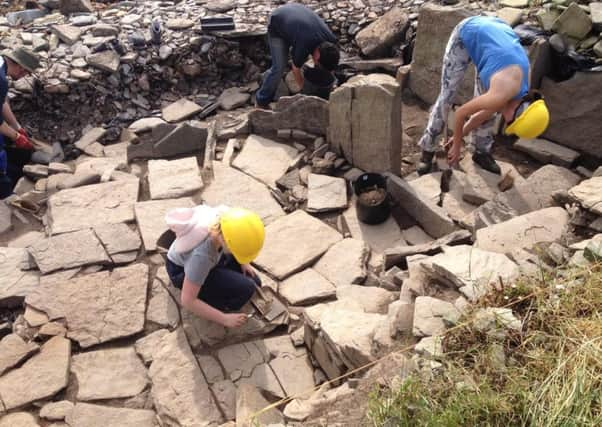Orkney archaeological dig is a battle between time and tide.


But there is a battle against time to find the whole truth hidden under the ground at Swandro as the sea continues to eat away at the land.
The dig is being led by the University of a Bradford and Orkney College UHI, and the ancient settlement was discovered by Dr Julie Bond in 2010.
Advertisement
Hide AdAdvertisement
Hide AdShe had spotted a few odd stones only just visible among the pebbles. Since then, the excavation has been changing the understanding of this site.
The tops of stones partly buried by the boulder beach turned out to be set uprights forming part of a prehistoric building around the high tide mark.
Although the tops of the stones are worn and battered by the sea, the beach has partly protected the deposits. Animal bone and pottery were recovered, finds suggesting an Iron Age context.
Initial clearance of the overlying beach material revealed a building, an Iron Age Roundhouse.
Only the landward circumference survived and contained a stone built oven and a cell with a large single flag cut to size forming the floor.
Two stone cut holes indicated post settings suggesting the support for an upper level possibly a loft around the circumference for storage in the roof space. Dr Bond said: “The seaward side has been savaged by the sea which has removed half or more of the structure.
“You can walk up terraced steps through time, rising from truncated material dating to the Middle Iron Age up to Late Iron Age and Norse features forming the upper erosion terrace adjacent to the wave-cut cliff.”
Advertisement
Hide AdAdvertisement
Hide AdWork has concentrated on the excavation of the infill of several buildings.
The apsidal northwestern end of the first building found, defined by upright stones settings and the internal dividing up right stones, revealed the presence of a flag floor and a stone oven set into the wall.
Under the flag floor and the remains of burnt clay, forming an earlier hearth had been eaten away by the sea.
The Iron Age sequence has been terraced into levels, rising from truncated material appearing to date to the Middle Iron Age up to Late Iron Age and Norse period deposits at the upper erosion terrace adjacent to the wave-cut cliff.
To the north-west the sea is eating into the side of what appears to be a Neolithic Chambered Cairn. It is this cairn which forms the mound of Swandro.
This suggests that the burial chamber may still be intact.
Work on the passage has indicated a much later infill dating to the Late Pictish and Viking period over the collapse, with the presence of several sheep with cut marks on the bone which had been made by a heavy iron blade and a coin of the Northumbrian King Eanred dating to the mid 9th Century AD.
The star find so far this year has been a copper alloy Roman Coin dating to the 4th century. The bronze coin is probably of Constans which would date from AD 348-350.
Advertisement
Hide AdAdvertisement
Hide AdThe reverse clearly shows the figure of the Emperor on galley standing left holding a Victory on globe. It was made in Trier, with the letters TRP clearly visible,indicating the mint.
Dr Stephen Dockrill, of the University of Bradford, said: “The work is investigating the archaeological remains in order to sample the floors of the eroding Early and Late Iron Age structures to unlock the buried evidence.
“Some of these buildings such as a small round building - where the 4th Century coin came from - have walling surviving to nearly a metre in height.
“However on the seaward side the waves have taken much of the wall completely away.
“The sea will destroy these buildings in the next year or so and this is our only chance to understand the generations who lived on this site.”
One building, a Pictish structure, has evidence for metalworking both iron smithing and the casting of copper alloy objects.
This was indicated by crucible fragments and a small part of a mould.
Advertisement
Hide AdAdvertisement
Hide AdThe Picts were the indigenous Late Iron Age people of Eastern Scotland and the Northern Isles, whose unique language and culture seem to have been obliterated by social and political changes of the ninth century, in which the Vikings played a major part.
The Project, directed by Dr Dockrill and Dr Bond, University of Bradford, is funded by Orkney Islands Council, Rousay, Egilsay & Wyre Development Trust, Orkney Archaeological Society, the University of Bradford, Orkney College, Hunter College, (City University of New York), William Paterson University.
The team say many thanks are due to the landowners Russell and Kathryn Marwick.
